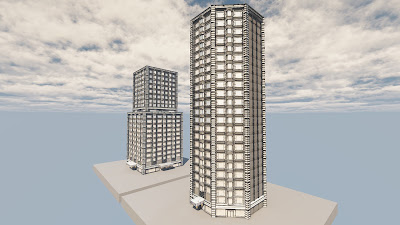Procedural Building System -WIP-
The procedural Building System allows a designer to quickly and efficiently create a building with specified rule set. The rule set can be as simple as just couple of nodes. However, in order to make a building that looks like a real building, more specific commands will be required.
This picture demonstrates the what the rule sets are capable of doing. The rule set above tells the ProcBuilding brush to place a flat window mesh and 3-sided window mesh next to each other on the brush. The brush size is 1800x1800x1800. The meshes were 320 units and 160 units, so they repeated 9 times on the X-axis. Then I've wrote the ruleset to place the frieze in between the window meshes all the way from bottom of the building to the top.
This picture shows updated version of the rule set. Now there are rather respectable looking corner piece as well as store windows for the bottom floor.
...More updates on the way...
-to be continued-
__________________________________________________________
In this update, there is an extra piece of mesh in between the straight window and 3-sided window. As a result, the rule set needed to be updated as well.
_________________________________________________________
The ruleset has been updated and close to being finalized for this particular project.
The rule set is capable of making irregular shaped buildings as well as rounded buildings.
The rule set has been created so that the user has the power to choose a wall that the user wants and make it a plain wall with no windows. More variations can be added as well.
___________________________________________________________________
(Aug 28,2013)
The proc building ruleset has been "finalized". It can never be quite finalized in my opinion.
-Proc Building-
The rectangular building has 2 proc building brushes.
As the viewers can see the awning that is built on the ground floor can't be found in the top portion of the building. That is because there's a variation node in the rule set which allows the user to choose whether to have or not have awnings.
The different variations are better visible on the octagonal shaped building. All the three visible sides are constructed with different variations, which the users have control over.
-modular kit (tessellated)-
The buildings are made up of 9 to 12 pieces. There are two variations for each of the 3 frieze meshes(straight, 3-sided, large).
The uses has the freedom to make their buildings with only one of the 2 variations or both.
The big appeal for this assets are the snow effect on top of the meshes.
In order to give the snow more body, I've applied tessellation which adapt to the camera position.
-proc building ruleset-
This represents roughly what my ruleset looks like. It is just matter of time before the ruleset gets many for variations and become extremely versatile.
End notes:
The Proc Building system is a rather powerful system which allows the users to create buildings instantly. The buildings are instance of each other meaning it will use less performance power than as if the buildings were created individually by pieces. One "annoying" aspect of the proc building is that the numbers has to be precise. Otherwise, there will be lights visible between the cracks of the meshes, or there will be annoying z fighting.
This knowledge of making proc building will pay off when making a whole city environment such as Rockstar's GTA series or other open world games for that matter.
This project was a good project for me to learn new techniques. This particular project gave me opportunities to learn about procedural building system, tessellation, and substance designer 3.5.
Substance Designer 3.5 allows an artist to create textures from node based work flow. The pros and cons of Substance Designer is debatable because it is essentially UDK's material editor, but in another software.
But in my experience, it is easier to use and I had to freedom to just drag in another texture (which they call it Filter) to my current project and create cohesive materials for an asset. In addition, the normal, spec, curvature, world normal, etc. maps can be created in the software by importing a custom mesh. As a result, the artist may create individual, precise textures for the mesh. Not the mention, the user has the ability to paint straight on to the mesh which is not available in UDK.
The project create in Substance Designer 3.5 can be published, meaning saved so it is compatible in UDK, and bring it straight into UDK and be able to tweak numbers instantly like material instance.
The total hours spent on the project adds up to be approximately 50 hours. The total hours include modeling, texturing, proc building ruleset creation, tessellation, and brainstorming.











